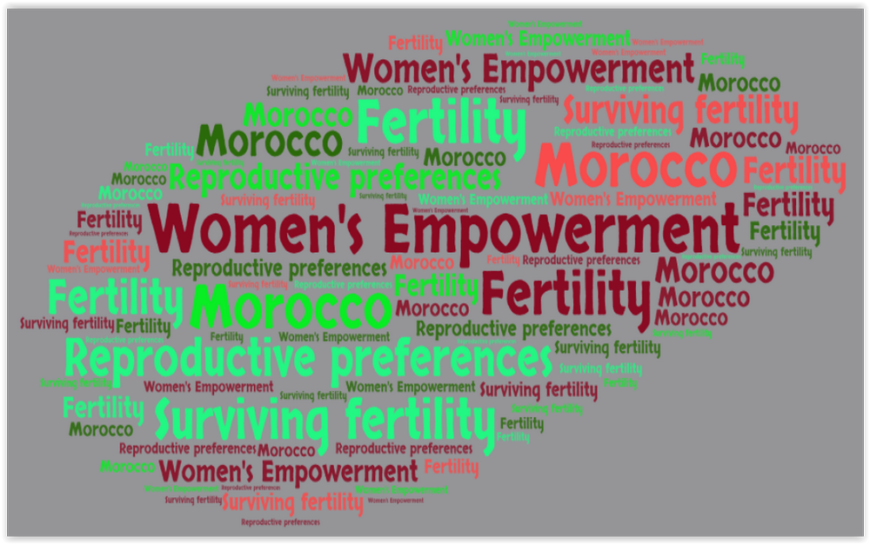Fertility Preferences and Outcomes in Morocco: Does Women’s Empowerment Matter in Actual-ideal Gap?
Chaimae Drioui, Fatima Bakass
Population Review
Volume 61, Number 1, 2022
Abstract:
In Morocco, the fertility transition process, like changes in fertility preferences, has been accompanied by a notable improvement in women’s status. The aim of this paper is to study the impact of Moroccan women’s empowerment on the actual-ideal gap, an indicator that measures the gap between two components, the number of surviving children and the ideal number of children, and hence on their ability to limit their fertility to this ideal. To build a good indicator of the empowerment, we used the SWPER composite index proposed in the literature, which is based on several dimensions, including participation in decision-making, attitude towards male violence, and other conventional measures of women’s status such as education and participation in economic activity. The empirical examination was conducted using the Skellam method, which models difference between two Poisson variables. Data were derived from two national population and family health surveys conducted in 2004 and 2011. The results indicate that there is a plausible negative association between women’s empowerment and the ideal number of children. However, the relationship with the number of surviving children is not always verified. The lack of a link between women’s empowerment and the actual-ideal gap can hide a non-symmetric and equally strong effect on its two components. Moreover, in an advanced transition context, women’s empowerment may not operate significantly on surviving fertility because of actual constraints like contraceptive efficiency and sex preferences.
Population Review
Volume 61, Number 1, 2022
Type: Article, pp. 1-30
Fertility Preferences and Outcomes in Morocco: Does Women’s Empowerment Matter in Actual-ideal Gap?
Authors: Chaimae Drioui and Fatima Bakass
Authors affiliations: National Institute of Statistics and Applied Economics, GEAS3D Laboratory, Morocco (Drioui); National Institute of Statistics and Applied Economics, GEAS3D Laboratory, Morocco (Bakass)
Corresponding author/address: Chaimae Drioui, National Institute of Statistics and Applied Economics, GEAS3D Laboratory, Morocco; email: cdrioui@insea.ac.ma
Abstract
In Morocco, the fertility transition process, like changes in fertility preferences, has been accompanied by a notable improvement in women’s status. The aim of this paper is to study the impact of Moroccan women’s empowerment on the actual-ideal gap, an indicator that measures the gap between two components, the number of surviving children and the ideal number of children, and hence on their ability to limit their fertility to this ideal. To build a good indicator of the empowerment, we used the SWPER composite index proposed in the literature, which is based on several dimensions, including participation in decision-making, attitude towards male violence, and other conventional measures of women’s status such as education and participation in economic activity. The empirical examination was conducted using the Skellam method, which models difference between two Poisson variables. Data were derived from two national population and family health surveys conducted in 2004 and 2011. The results indicate that there is a plausible negative association between women’s empowerment and the ideal number of children. However, the relationship with the number of surviving children is not always verified. The lack of a link between women’s empowerment and the actual-ideal gap can hide a non-symmetric and equally strong effect on its two components. Moreover, in an advanced transition context, women’s empowerment may not operate significantly on surviving fertility because of actual constraints like contraceptive efficiency and sex preferences.
Keywords
Actual-ideal gap, Demographic and Health Survey, fertility, Morocco, reproductive preferences, surviving fertility, SWPER index, women’s empowerment
© 2022 Sociological Demography Press
MLA
Drioui, Chaimae and Fatima Bakass. “Fertility Preferences and Outcomes in Morocco: Does Women’s Empowerment Matter in Actual-ideal Gap?” Population Review, vol. 61 no. 1, 2022, p. 1-30. Project MUSE muse.jhu.edu/article/842810.
APA
Drioui, C., & Bakass, F. (2022). Fertility Preferences and Outcomes in Morocco: Does Women’s Empowerment Matter in Actual-ideal Gap?Population Review 61(1), 1-30. https://www.muse.jhu.edu/article/842810.
Chicago
Drioui, Chaimae, and Fatima Bakass. “Fertility Preferences and Outcomes in Morocco: Does Women’s Empowerment Matter in Actual-ideal Gap?” Population Review 61, no. 1 (2022): 1-30. muse.jhu.edu/article/842810.
Endnote
TY – JOUR T1 – Fertility Preferences and Outcomes in Morocco: Does Women’s Empowerment Matter in Actual-ideal Gap? A1 – Drioui, Chaimae A1 – Bakass, Fatima JF – Population Review VL – 61 IS – 1 SP – 1 EP – 30 PY – 2022 PB – Sociological Demography Press SN – 1549-0955 UR – https://muse.jhu.edu/article/842810 N1 – Volume 61, Number 1, 2022 ER –
Always review your references for accuracy and make any necessary corrections before using. Pay special attention to personal names, capitalization, and dates. Consult your library for more information on citing sources.




